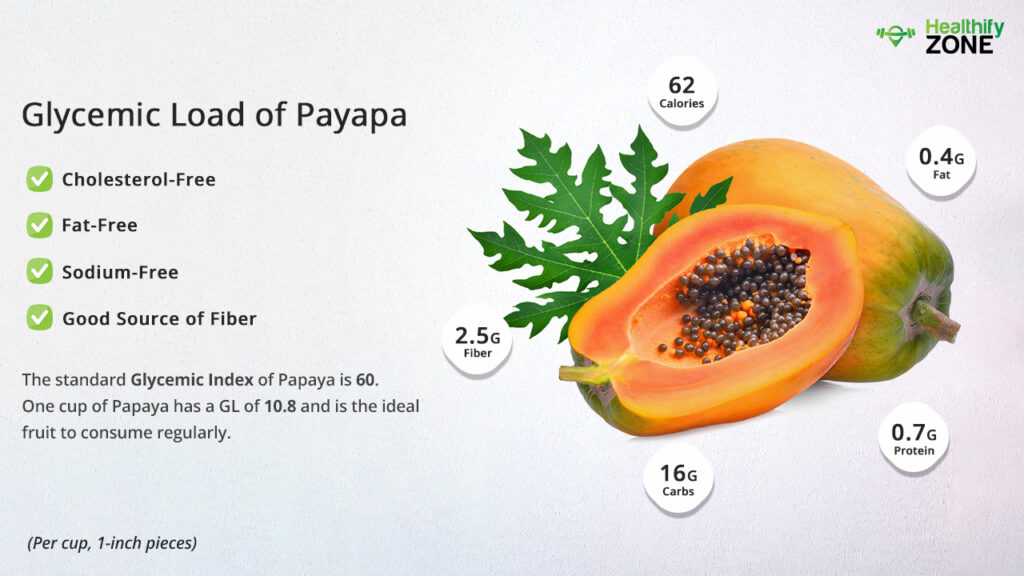Glycemic Load is the quantity of carbohydrate content present in the food, along with how quickly it increases the blood sugar levels. The Glycemic Index is a simple way of making healthier diet choices. It helps compare the alternative sources of nutrients according to blood glucose levels. Glucose has a relatively high blood glucose response in comparison to fructose.
Papaya is a very healthy tropical fruit. It has loads of antioxidants that reduce inflammation, fights disease, and keeps you looking young. The International GI Tables suggest that it has a glycemic index of 60. Papayas have an enzyme called papain that breaks down tough protein chains, which are found in muscle meat. They also have healthy antioxidants called carotenoids and lycopene, which get better absorbed in comparison to other fruits.
Papaya is a tropical fruit that is high in Vitamins, fiber, and healthy plant compounds.
- Vitamin A- Good for Vision and Eye strength
- Vitamin C – Improves the heart-capacity, prevents cancer, etc.
- Potassium
- Vitamin B-9- Folate
- Protein
- Magnesium
- Trace amounts of vitamins B1, B3, B5, E, and K.
How to Calculate Glycemic Load of Papaya?
The standard Glycemic index of papaya is 60. The high glycemic index of the fruit helps in reducing the risks related to cardiovascular diseases. If we want to talk about diet, the key to prevent diabetes or any chronic illness is to distribute the carbohydrate consumption content throughout the day and manage the sugar levels in the body correctly—owing to the low amounts of carbs; you can take Papaya anytime during the day.

The Formula/Procedure For Calculation of Glycemic Load of Papaya:
GL = GI * carbs / 100
where
- GL – glycemic load;
- GI – glycemic index;
- and carbs – the amount of carbohydrates in the portion.
| SL.NO | PAPAYA BY WEIGHT IN (g) | GLYCEMIC LOAD |
| 1. | 100 g of Papaya | 6.6 (low) |
| 2. | 250 g of Papaya | 14.4 (medium) |
| 3. | 500 g of Papaya | 29 (high) |
| 4. | 1 Kg of Papaya | 66 (very high) |
| 5. | One Whole Papaya (780 g) | 51 (very high) |
| 6. | 1 Cup of Papaya (175 g) | 10.8 (low) |
Is Papaya Safe to Consume If You Have Diabetes?
Using the Glycemic Index, one can identify how fast a given food can increase your blood sugar levels. This is great for people with diabetes to monitor their blood sugar levels. Papaya has a Glycemic Index of 60, so it does not raise blood sugar too quickly. In fact, it is a great choice for people who have diabetes, and the consumption of papaya can actually help in the regulation of blood sugar. Studies suggest that papaya has a hypoglycemic effect, and flavonoids are natural antioxidants that help in regulating blood sugar.
Can I Eat Papaya During a Fat-Loss Diet?
You can eat papaya during a strict fat-loss diet. If you are looking for good results, you should avoid having more than 100 g of papaya per serving.

- A 250 g serving of papaya has a GL of 14.4 which is in the permissible levels.
- A whole papaya or even 500g of it is something which shoud be taken rarely if you are on a fat-loss diet.
- Papaya as a fruit salad ingredient is premissible in a fat-loss diet.
Can I Eat Papaya During a Low-Carbohydrate Diet?
You can consume papaya during a strict low-carb diet. However, the quantity is something that you need to take into account. We suggest you not consume more than 200 g of papaya per serving. This would contain about 13.8 g of carbohydrates, which is alright.
Is Papaya High in Sugar?
A 100 g of papaya has 6.9 g of carbohydrates and the same amount of sugar. Although sugary, it will not increase your blood glucose level, as is clear from its glycemic index. This is a great fruit to consume on a daily basis.